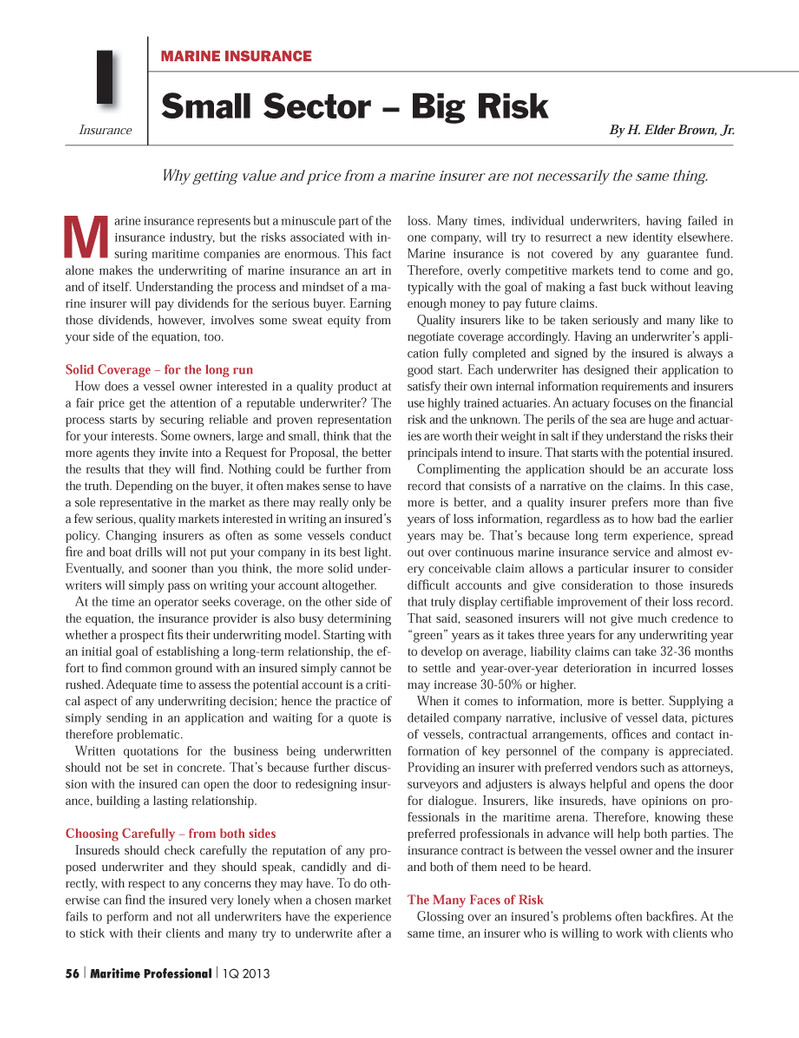
Page 56: of Maritime Logistics Professional Magazine (Q1 2013)
Maritime Risk
Read this page in Pdf, Flash or Html5 edition of Q1 2013 Maritime Logistics Professional Magazine
Marine insurance represents but a minuscule part of the insurance industry, but the risks associated with in- suring maritime companies are enormous. This fact alone makes the underwriting of marine insurance an art in and of itself. Understanding the process and mindset of a ma-rine insurer will pay dividends for the serious buyer. Earning those dividends, however, involves some sweat equity from your side of the equation, too. Solid Coverage ? for the long run How does a vessel owner interested in a quality product at a fair price get the attention of a reputable underwriter? The process starts by securing reliable and proven representation for your interests. Some owners, large and small, think that the more agents they invite into a Request for Proposal, the better the results that they will Þ nd. Nothing could be further from the truth. Depending on the buyer, it often makes sense to have a sole representative in the market as there may really only be a few serious, quality markets interested in writing an insuredÕs policy. Changing insurers as often as some vessels conduct Þ re and boat drills will not put your company in its best light. Eventually, and sooner than you think, the more solid under- writers will simply pass on writing your account altogether. At the time an operator seeks coverage, on the other side of the equation, the insurance provider is also busy determining whether a prospect Þ ts their underwriting model. Starting with an initial goal of establishing a long-term relationship, the ef-fort to Þ nd common ground with an insured simply cannot be rushed. Adequate time to assess the potential account is a criti- cal aspect of any underwriting decision; hence the practice of simply sending in an application and waiting for a quote is therefore problematic.Written quotations for the business being underwritten should not be set in concrete. ThatÕs because further discus- sion with the insured can open the door to redesigning insur- ance, building a lasting relationship. Choosing Carefully ? from both sides Insureds should check carefully the reputation of any pro- posed underwriter and they should speak, candidly and di-rectly, with respect to any concerns they may have. To do oth- erwise can Þ nd the insured very lonely when a chosen market fails to perform and not all underwriters have the experience to stick with their clients and many try to underwrite after a loss. Many times, individual underwriters, having failed in one company, will try to resurrect a new identity elsewhere. Marine insurance is not covered by any guarantee fund. Therefore, overly competitive markets tend to come and go, typically with the goal of making a fast buck without leaving enough money to pay future claims. Quality insurers like to be taken seriously and many like to negotiate coverage accordingly. Having an underwriterÕs appli- cation fully completed and signed by the insured is always a good start. Each underwriter has designed their application to satisfy their own internal information requirements and insurers use highly trained actuaries. An actuary focuses on the Þ nancial risk and the unknown. The perils of the sea are huge and actuar- ies are worth their weight in salt if they understand the risks their principals intend to insure. That starts with the potential insured. Complimenting the application should be an accurate loss record that consists of a narrative on the claims. In this case, more is better, and a quality insurer prefers more than Þ ve years of loss information, regardless as to how bad the earlier years may be. ThatÕs because long term experience, spread out over continuous marine insurance service and almost ev- ery conceivable claim allows a particular insurer to consider difÞ cult accounts and give consideration to those insureds that truly display certiÞ able improvement of their loss record. That said, seasoned insurers will not give much credence to ÒgreenÓ years as it takes three years for any underwriting year to develop on average, liability claims can take 32-36 months to settle and year-over-year deterioration in incurred losses may increase 30-50% or higher. When it comes to information, more is better. Supplying a detailed company narrative, inclusive of vessel data, pictures of vessels, contractual arrangements, ofÞ ces and contact in- formation of key personnel of the company is appreciated. Providing an insurer with preferred vendors such as attorneys, surveyors and adjusters is always helpful and opens the door for dialogue. Insurers, like insureds, have opinions on pro- fessionals in the maritime arena. Therefore, knowing these preferred professionals in advance will help both parties. The insurance contract is between the vessel owner and the insurer and both of them need to be heard.The Many Faces of Risk Glossing over an insuredÕs problems often backÞ res. At the same time, an insurer who is willing to work with clients who Insurance MARINE INSURANCESmall Sector ? Big RiskIBy H. Elder Brown, Jr. Why getting value and price from a marine insurer are not necessarily the same thing. 56 | Maritime Professional | 1Q 2013MP #4 50-63.indd 56MP #4 50-63.indd 562/25/2013 9:57:07 AM2/25/2013 9:57:07 AM

 55
55

 57
57
